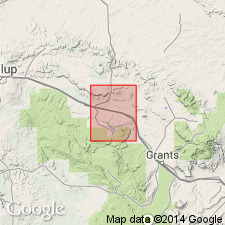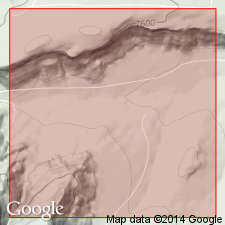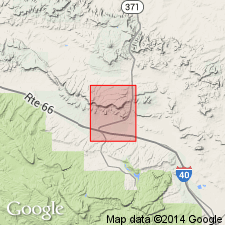
- Usage in publication:
-
- Prewitt sandstone member
- Modifications:
-
- Named
- Dominant lithology:
-
- Sandstone
- AAPG geologic province:
-
- San Juan basin
Summary:
Named as the middle member of the Morrison formation for exposures along cliffs north of U.S. Hwy 66 north of Prewitt, McKinley Co, NM in the San Juan basin. Type section designated at sec 9, T14N R13W, west of Mt. Powell, west part Thoreau quad. Mapped along north part of quad (geologic map) from west side to within less than 1 mi of the east edge of the quad. Overlies Chavez member (new) of Morrison. The lower contact is a scoured surface. Some scours have a relief of 4 to 5 ft. Underlies Brushy Basin member of Morrison. Is equivalent to the Westwater Canyon member of the Morrison of northeast AZ and southeast UT. Consists of brown-weathering, massive, coarse-grained, poorly sorted, cross-bedded, cliff-forming, pinkish-red conglomeratic sandstone. Contains 10-15 percent red chert and chalky feldspar grains, and a small amount of green mud balls. Is 185 to 190 ft thick at type. Thins east and west of quad. Columnar section. Of Jurassic age.
Source: GNU records (USGS DDS-6; Denver GNULEX).

- Usage in publication:
-
- Prewitt Member
- Modifications:
-
- Contact revised
- AAPG geologic province:
-
- San Juan basin
Summary:
Upper contact revised in McKinley Co, NM, San Juan basin, in that Prewitt is overlain by the newly named Casamero Member of the Morrison Formation. Casamero is a replacement name for Brushy Basin Member of Morrison in this area. Uppermost Prewitt at type locality of Casamero is a massive, coarse- to medium-grained, poorly sorted, pinkish-white conglomeratic sandstone. The basal Casamero is a poorly sorted rusty-brown to greenish sandstone. [Jurassic age implied.]
Source: GNU records (USGS DDS-6; Denver GNULEX).

- Usage in publication:
-
- Prewitt Member
- Modifications:
-
- Not used
Summary:
Not used. Shown on a correlation chart as used by Smith (1954) and as equivalent to the Westwater Canyon Member of the Morrison Formation. Westwater Canyon used as middle member of Morrison in map area in preference to Prewitt.
Source: GNU records (USGS DDS-6; Denver GNULEX).
For more information, please contact Nancy Stamm, Geologic Names Committee Secretary.
Asterisk (*) indicates published by U.S. Geological Survey authors.
"No current usage" (†) implies that a name has been abandoned or has fallen into disuse. Former usage and, if known, replacement name given in parentheses ( ).
Slash (/) indicates name conflicts with nomenclatural guidelines (CSN, 1933; ACSN, 1961, 1970; NACSN, 1983, 2005, 2021). May be explained within brackets ([ ]).

